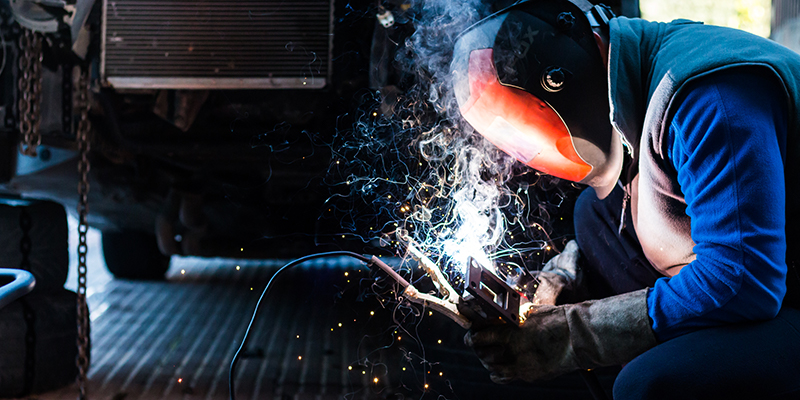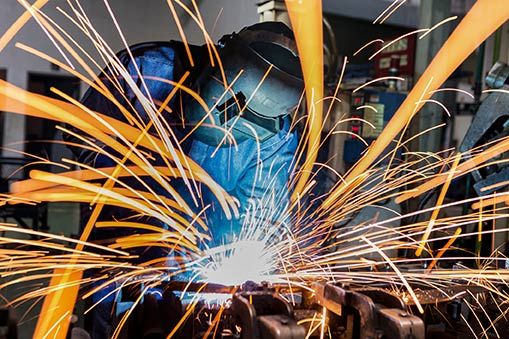Early defect indicators and what Belgrade can do about them
Wiki Article
Common Welding Repair Work Issues and Exactly How to Address Them Properly
Welding fixings often run into a series of concerns that can endanger the integrity of the end product. Usual issues include insufficient infiltration, porosity, and misalignment, amongst others. Each flaw provides distinct challenges that require certain methods for resolution. Understanding these problems is essential for welders aiming to boost their outcomes and skills. This discussion will check out these usual welding repair concerns and efficient techniques to address them.Poor Penetration
Poor infiltration takes place when the weld metal fails to completely fuse with the base material, causing weak joints and potential architectural failures. This issue frequently originates from inadequate warmth input, wrong electrode angle, or inappropriate welding rate. Welders may encounter insufficient infiltration because of a mistake of the necessary parameters for a specific product density or kind. Additionally, contamination on the base product's surface area can hinder reliable bonding, worsening the issue. To deal with inadequate penetration, welders should guarantee ideal settings on their devices and maintain a clean job surface. Normal inspection of welds is advised to determine any deficiencies early, enabling timely adjustments and the prevention of endangered structural honesty in bonded settings up.Porosity
Porosity is a common defect in bonded joints that manifests as little gas bubbles caught within the weld metal. This issue can jeopardize the stability of the weld, resulting in minimized strength and prospective failure under anxiety. Montana Mobile Welding and Repair Belgrade Welding. Porosity normally arises from contamination, moisture, or incorrect welding methods, which permit gases to leave into the molten weld swimming pool. To deal with porosity, welders need to assure appropriate surface preparation, maintain a tidy working environment, and make use of ideal welding specifications. Furthermore, selecting the ideal filler material and securing gas can minimize gas entrapment. Regular examination and screening of welds can help recognize porosity early, ensuring timely corrective activities are taken, thus maintaining the top quality and reliability of the bonded frameworkMisalignment
Imbalance in welding can occur from numerous aspects, including incorrect configuration and thermal growth. Understanding the source is essential for reliable resolution. Numerous correction techniques are available to realign elements and assure architectural honesty.Reasons of Misalignment
Welding misalignment often comes from a variety of underlying issues that can endanger structural stability. One key reason is incorrect fit-up of parts prior to welding, which can bring about spaces and unequal surface areas. Variants in thermal development during the welding procedure can additionally lead to distortion, specifically if the materials being signed up with have various coefficients of growth. Additionally, insufficient fixturing and securing may fall short to hold components securely in position, resulting in activity during welding. Inadequately conserved devices, including welding machines and tools, might present variances in the weld bead, more adding to imbalance. Driver error, stemming from inadequate training or experience, can also play a substantial duty in producing misaligned welds.
Adjustment Methods Available
Dealing with misalignment effectively requires a mix of restorative strategies tailored to the details problems at hand. One usual technique is the usage of jigs or fixtures to hold elements in the appropriate placement throughout welding, making sure consistent positioning. In addition, pre-heating the products can help minimize distortion and improve fit-up. For substantial imbalance, mechanical adjustment strategies, such as using hydraulic jacks or clamps, can be used to deal with the position prior to welding. Post-weld warmth therapy might also be necessary to relieve stresses triggered by imbalance. Ultimately, careful inspection and adjustment throughout the configuration phase can stop imbalance concerns from coming to be considerable problems, promoting a smoother welding procedure and enhancing general architectural integrity.Distortion
Distortion is an usual obstacle in welding that can arise from various variables, including irregular cooling and heating. Understanding the root causes of distortion is important for executing efficient avoidance methods. Resolving this problem not just boosts architectural honesty yet also improves the total quality of the weld.Root causes of Distortion
When subjected to the extreme warm of welding, products frequently undergo modifications that can result in distortion. This sensation mostly emerges from thermal expansion and contraction during the welding process. As the weld area heats up, the product broadens; upon cooling, it acquires, which can produce internal stress and anxieties. In addition, unequal home heating across a work surface can aggravate these stresses, leading to bending or bending. The sort of material additionally plays a significant function; steels with varying thermal conductivity and coefficients of expansion might respond in a different way, resulting in unpredictable distortions. Furthermore, inadequate joint style and inadequate fixturing can contribute to imbalance throughout welding, enhancing the likelihood of distortion. Comprehending these reasons is crucial for reliable welding fixing and avoidance techniques.Prevention Techniques
Reliable avoidance techniques for distortion during welding concentrate on managing warmth input and ensuring proper joint design. Maintaining a constant warmth input aids to reduce thermal expansion and tightening, which can link cause distortion. Making use of techniques such as pre-heating the work surface can additionally minimize the temperature level gradient, advertising consistent home heating. Furthermore, selecting appropriate joint layouts, such as T-joints or lap joints, can boost stability and reduce stress focus. Implementing appropriate fixturing to secure the work surfaces in position additionally help in maintaining placement throughout the welding process. Staggered welding series can distribute heat more uniformly, preventing local distortion. By using these approaches, welders can substantially decrease the likelihood of distortion and improve the total high quality of their welds.Breaking
Cracking is an usual problem experienced in welding repairs, commonly arising from various aspects such as improper cooling prices, material option, or poor joint preparation. The incident of splits can greatly endanger the integrity of the weld, resulting in possible failings during procedure. To resolve this problem, welders need to first assess the source, making certain that products are suitable and appropriately picked for the certain application. Additionally, managing the air conditioning price during the welding procedure is necessary; rapid cooling can cause stress and anxiety and lead to breaking. Correct joint style and prep work also add to lessening the risk. Executing these techniques can improve weld high quality and longevity, ultimately minimizing the possibility of fracturing in finished weldments.
Insufficient Blend
A significant problem in welding repair services is incomplete combination, which takes place when the weld steel does not properly bond with the base product or previous weld passes - Montana Mobile Welding and Repair Belgrade Fabrication. This defect can cause weaknesses in the joint, potentially jeopardizing the integrity of the bonded framework. Variables contributing to insufficient combination include insufficient warmth input, incorrect welding strategy, and contamination of the surface areas being joined. To resolve this concern successfully, welders must assure appropriate pre-weld cleaning and surface area prep work, along with change welding steel their welding criteria to accomplish adequate penetration and fusion. Regular assessment during the welding process can also aid recognize incomplete combination early, permitting timely rehabilitative measures to enhance the total high quality of the weldOverheating
While welding repair services can enhance architectural stability, overheating provides a significant challenge that can result in product deterioration. Extreme warmth during welding can modify the mechanical properties of metals, resulting in decreased toughness, boosted brittleness, and warping. This sensation is specifically critical in high-stress applications where structural dependability is vital. Identifying overheating can entail aesthetic evaluations for discoloration or distortion, as well as keeping track of temperature level during the welding procedure. To mitigate the risks connected with overheating, welders should employ ideal methods, such as controlling heat input, readjusting traveling speed, and utilizing ideal filler products. Additionally, executing pre- and post-weld heat therapies can assist recover material residential properties and boost the overall high quality of the repair work, guaranteeing long-term performance and safety and security.Regularly Asked Concerns
What Are the Common Signs of a Welding Flaw?

Just How Can I Test My Welds for High quality?
To examine welds for high quality, one can make use of aesthetic inspections, ultrasonic screening, and radiographic methods. Each method guarantees structural integrity, identifies problems, and confirms adherence to specified criteria, ultimately enhancing the integrity of the bonded joints.What Safety and security Safety Measures Should I Take While Welding?
When welding, one should prioritize safety and security by putting on appropriate individual safety tools, ensuring appropriate ventilation, safeguarding combustible materials away, maintaining a tidy workspace, and knowing surroundings to stop accidents and injuries.Can I Fix a Weld Without Remodeling the Entire Joint?
Fixing a weld without redoing the entire joint is feasible, relying on the damage (Montana Mobile Welding and Repair Welding). Strategies such as grinding, adding filler product, or making use of a welding process can successfully address particular flaws while preserving the surrounding frameworkWhat Tools Are Necessary for Efficient Welding Services?
Necessary tools for reliable welding repair work consist of a welding device, cable brush, mill, protective equipment, clamps, and filler materials. Each device plays a vital role in ensuring high quality and safety during click to read the repair procedure. Porosity commonly occurs from contamination, wetness, or improper welding methods, which allow gases to escape right into the molten weld swimming pool. Inadequately conserved tools, including welding machines and devices, may present incongruities in the weld grain, further contributing to imbalance. When subjected to the extreme warmth of welding, products usually go through adjustments that can lead to distortion. Breaking is a typical concern experienced in welding repair services, frequently resulting from different aspects such as improper cooling rates, material selection, or inadequate joint preparation. A substantial concern in welding repair services is incomplete fusion, which takes place when the weld steel does not appropriately bond with the base material or previous weld passes.Report this wiki page